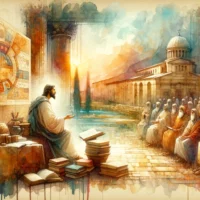The life and ministry of Jesus Christ, as depicted in the Holy Bible, is a story that has reverberated through the ages, captivating millions of hearts and minds. But why did Jesus, the Son of God, choose to walk among us? What was the purpose of His life and ministry? This article aims to explore these questions, offering a detailed examination of Jesus’ mission, as defined by the Biblical text.
Jesus as the Fulfillment of Old Testament Prophecy
The first major purpose of Jesus’ life and ministry, as understood within the Christian faith, is His role as the fulfillment of Old Testament prophecies. The Old Testament, a sacred text shared by both Judaism and Christianity, contains numerous prophecies that foretell the coming of a Messiah. This Messiah, it is prophesied, would be a figure of salvation and deliverance, a beacon of hope for all people (Isaiah 53).
Jesus is seen by Christians as this prophesied Messiah. His birth in Bethlehem to a virgin, His teachings and miracles, His suffering, death, and resurrection – all of these aspects of Jesus’ life are seen as fulfilling specific prophecies made centuries before His time. The Gospel accounts are filled with references to these prophecies, making it clear that Jesus didn’t merely happen upon the scene but was expected and anticipated (Matthew 1:22-23, Luke 4:16-21).
Take, for example, the prophet Isaiah’s vision of a servant who would suffer for the sins of others. This “suffering servant,” as Isaiah described, would be pierced for our transgressions and crushed for our iniquities, bringing peace through His sacrifice (Isaiah 53:5). Christians see in this prophecy a clear foreshadowing of Jesus’ crucifixion and the purpose of His death.
The Messiah was also prophesied to be a teacher of righteousness, leading people back to God. Jesus, through His teachings and parables, demonstrated this role vividly, guiding His followers towards a life of love, mercy, and humility, as prescribed in the teachings of the Law and the Prophets (Matthew 5:17-20).
The concept of Jesus as the fulfillment of Old Testament prophecies is central to understanding His purpose. It underscores the continuity of God’s plan for humanity, from the ancient times of the Old Testament to the dawn of the New Testament era. It provides a context for His life and ministry, situating Him within a divine narrative that stretches back centuries.
Our journey into understanding the purpose of Jesus’ life and ministry begins with the recognition of His role as the prophesied Messiah. This recognition establishes Jesus not as a random figure, but as a divine plan’s cornerstone. It is through this lens that the other aspects of His life – His teachings, His miracles, His death, and resurrection – gain deeper significance. The journey doesn’t stop here, though, as we proceed to explore His ministry’s active components, like His teachings, His healing works, and His forgiveness.
The Ministry of Jesus: Teaching, Healing, and Forgiving
Having considered Jesus as the fulfillment of Old Testament prophecies, we can now delve into the active aspects of His ministry. Central to Jesus’ purpose were His roles as a teacher, healer, and forgiver. His teachings provided a new understanding of God’s will, His healings demonstrated God’s power and mercy, and His forgiveness emphasized God’s limitless love.
Jesus’ teachings were the cornerstone of His ministry. They offered a fresh, transformative perspective on spiritual truths. He taught not just in words but through stories or parables, making complex ideas about God’s kingdom more relatable to everyday life (Matthew 13:34-35). He emphasized love, forgiveness, humility, and the need to seek God’s Kingdom above all else (Matthew 5-7).
In addition to His teachings, Jesus’ healing ministry was a significant part of His work. He healed the sick, gave sight to the blind, and even raised the dead (Mark 5:21-43, John 9:1-7). These miracles served as signs of God’s kingdom, demonstrating that with God, nothing is impossible. They were also acts of compassion, showing God’s love for all, especially those who were suffering.
The third crucial aspect of Jesus’ ministry was His role as a forgiver. Jesus offered forgiveness to those who turned to Him, no matter their past. He forgave sins, a power that was, according to Jewish tradition, reserved for God alone, which indicated His divine authority (Mark 2:1-12). Jesus’ forgiveness extended to everyone, even to those who society had marginalized or deemed unworthy.
This exploration of Jesus’ active ministry—His teaching, healing, and forgiving—further clarifies His purpose. These roles highlighted the nature of God’s Kingdom and provided a roadmap for how to live according to God’s will. They were practical demonstrations of God’s love and power, serving as tangible proof of the divine truth Jesus proclaimed.
With a grasp of the active aspects of Jesus’ ministry, we can see how His life was not just about fulfilling prophecies but also about transforming lives. He did not merely preach abstract ideas; instead, His teachings were brought to life through acts of healing and forgiveness. In our final section, we will delve into the ultimate act of Jesus’ ministry, His sacrifice, which serves as the greatest testament to His purpose and the epitome of His love for humanity.
Jesus’ Sacrifice: The Ultimate Act of Love
The culmination of Jesus’ life and ministry is found in His sacrifice on the cross. This act, according to Christian belief, is the ultimate expression of divine love, grace, and redemption. It’s the linchpin of Jesus’ purpose, bringing together all the threads of prophecy, teaching, healing, and forgiving into a single, powerful moment.
The crucifixion of Jesus was more than just a historical event; it was a divine act of atonement. In Christian understanding, humanity’s sin had created a barrier between us and God. Jesus, by willingly offering Himself on the cross, took upon Himself the weight of all our sins. He suffered and died so that the barrier of sin could be broken, and the relationship between God and humanity could be restored (Romans 5:6-8).
But Jesus’ sacrifice wasn’t just about His death; it also included His resurrection. After being crucified, Jesus was buried, but on the third day, He rose again, as witnessed by His disciples (1 Corinthians 15:3-8). The resurrection is seen as a victory over death and sin. It’s a testimony to life eternal, a promise that those who believe in Jesus will also overcome death and live forever with God (John 11:25-26).
The sacrifice of Jesus, His death, and resurrection, embody the heart of the Christian faith. It’s seen as the ultimate act of love—God’s love for humanity. Jesus willingly laid down His life for us, paying the price for our sins, to open the way to eternal life. It’s an act of grace that, in Christian belief, transcends human understanding and underscores the profound depth of God’s love.
Jesus’ sacrifice on the cross is the defining moment of His life and ministry. It is the epitome of His purpose: to reconcile humanity with God through an act of selfless love. This sacrifice, paired with His resurrection, gives a fuller picture of Jesus’ role as the Messiah, not only fulfilling prophecies but also demonstrating the power and depth of divine love. Through this exploration, we see Jesus not only as a teacher, healer, and forgiver but as the Savior, offering hope, redemption, and eternal life to all who believe in Him.
Reflecting on the Divine Purpose
Jesus’ life and ministry, as we’ve explored, was a journey marked by prophecy fulfillment, profound teachings, miraculous healings, forgiveness, and the ultimate sacrifice of love. Each aspect of His earthly mission weaves into a divine tapestry that reveals His purpose: to reveal God’s love, redeem humanity, and offer the promise of eternal life.
As we wind up, here are three personal questions to ponder:
- How does the understanding of Jesus as the fulfillment of prophecies impact your view of His purpose?
- In what ways do Jesus’ teachings, healings, and acts of forgiveness resonate with your own life experiences?
- How does the sacrificial act of Jesus’ crucifixion and resurrection influence your perspective on God’s love?
As we step away from this exploration, let us be moved by the knowledge that Jesus’ life and ministry was an outpouring of divine love. The Son of God walked among us, sharing our joys, our sorrows, our hopes, and fears, all to bring us closer to our heavenly Father. His journey wasn’t easy, but it was driven by a love so profound that it changed the world. Let this love inspire us, guide us, and fill us with hope as we strive to live out our own journeys of faith. May we walk in His footsteps, embracing the love He showed us and sharing it with those around us. In His example, we find our own purpose, rooted in love and shaped by grace.














